ISSN ONLINE(2319-8753)PRINT(2347-6710)
ISSN ONLINE(2319-8753)PRINT(2347-6710)
O. B. Oguntuase1, I. A. Daniyan2 and A. O. Adeodu2
|
| Related article at Pubmed, Scholar Google |
Visit for more related articles at International Journal of Innovative Research in Science, Engineering and Technology
The gap between what higher institutions offer and the demands of the labour market is widening by the day. Graduates are more exposed to theory than the practical aspects of their training. In recent time, there has been increased awareness on the need to match theory with practice, hence, the need for Students’ Work Experience Programme. The design and fabrication of burglary and assembly of aluminium glass window was done during the 2012/ 2013 Students’ Work Experience Programme (SWEP) undertaken at Afe Babalola University, Ado Ekiti, Nigeria (ABUAD) by all 200 and 300 level engineering students. The Students’ Work Experience Programme (SWEP) was designed not only to expose the students to skill acquisition, but also to inculcate in them the development of right team spirit as well as to expose them to rudimentary expectations in their chosen career. The SWEP cut across three key Engineering fields namely: Mechanical, Electrical and Civil. The Mechanical aspect comprises of design and fabrication of burglary using 16 mm mild steel as well as aluminum glass window assembly. The burglary was fabricated according to designed values using shielded metal arc welding, after which it was painted with antirust paint to prevent corrosion. After the successful completion of the SWEP, students were resourcefully engaged in design and fabrication as well as other various engineering projects within the school bringing about development of products to specification, thereby, developing students’ innovative and creative ability in overcoming technical and professional challenges
Keywords |
| Burglary, Corrosion, Design, Fabrication, Shielded metal arc welding. |
INTRODUCTION |
| Afe Babalola University Ado Ekti, Nigeria (ABUAD), like some other universities, engineering students undertake summer programmes in-house at the end of 200 and 300 level for Students’ Work Experience Programme (SWEP). The students’ Work Experience Programme (SWEP) was established to enable students of tertiary institution have basic technical knowledge of industrial works base on their course of study before the completion of their programme in their respective institutions. The scheme was designed to expose students to industrial environment and enable them develop occupational competencies so that they can readily contribute their quota to national, economic and technological development after graduation. Theoretical knowledge alone would not sufficiently prepare an educated person for the world of work. A university graduate must not only be knowledgeable theoretically but must also be versatile in the application of skills to perform defined jobs or work. |
II. WELDING PROCESS |
| The term welding is used to cover a wide range of bonding techniques. Welding is a manufacturing process used to join sculptural materials, usually metals or thermoplastics, by coalescence. This is often done by fusing the work pieces and adding a filler material to form a pool of molten material (the solder bath) that cools to become a strong, with pressure sometimes used in conjunction with heat, or by itself, to produce the weld. The term weldability has been defined as the capacity of metal to be welded under the fabrication conditions imposed into a specific, suitably designed structure and to perform satisfactorily in the intended service [1]. There are different types of welding process in the welding history. Few of which are listed below: Gas welding, arc welding, resistance welding,, solid state welding etc. To prevent injury and arc eyes a welder must wear personal safety equipment such as welding google, leather glove, overall, welding helmet etc. |
1. Gas Welding |
| Gas welding is a welding process that uses fuel gases and oxygen during welding operation. Gas welding is one of the oldest welding processes. Still used in industry, in recent decades it has been less widely utilized in industrial applications as other specifically devised technologies have been adopted. It is still widely used for welding pipes and tubes, as well as repair work. It is also frequently well-suited, and favored, for fabricating some types of metal-based artwork. As well, gas welding has an advantage over electric welding and cutting processes in situations where accessing electricity (e.g., via an extension cord or portable generator) would present difficulties; it is more self-contained, in this sense — hence "more portable". |
2. Arc Welding |
| Arc welding is a method of welding that uses a welding power supply to create an electric arc between an electrode and the base material to melt the metals at the welding point. It involves the use of either direct (DC) or alternating (AC) current, and consumable or non-consumable electrodes. The welding region is usually protected by some type of shielding gas, vapour, or slag. Arc welding processes may be manual, semi-automatic, or fully automated [2], [3]. Today it remains an important process for the fabrication of steel structures and vehicles. For the purpose of work, shielded metal arc welding is used. The shielded metal arc welding is one of the most common types of arc welding [4], highly versatile and can be performed with relatively inexpensive equipment [5]. Pipeline and structural welders use this method the most because of its deep 'penetration' (how much it digs into the base metal), and pressure handling capabilities [6]. |
3. Resistance Welding |
| Resistance welding is a welding technique in which the parts to be joined are held together under pressure and heat is produced by passing a current through the contact resistance formed between the two surfaces. |
4. Solid State Welding |
| This a process of joining two metals together by vibrating them at high frequency and under high pressure. The equipment and methods involved are similar to that of resistance welding, but instead of electric current, vibration is used to provide energy input. Welding metals with this process does not involve melting the materials; instead, the weld is formed by introducing mechanical vibrations horizontally under pressure. Broadly, welding process could be classified as plastic, fusion welding and solid- phase welding [7]. |
| 1. Plastic welding: In this case, pieces of metal t be joined are heated to the plastic state and forced together by external pressure without the addition of a filler material e.g. forge welding, thermit welding etc. 2. Fusion welding: This is the process of joining metal by the application of heat and a filler material. The metal at the joint is heated to a molten state and allowed to solidify. e.g. gas welding, arc welding etc. 3. Solid phase welding: This involves making welds by the creation of metallic bond between the surfaces being joined. |
| To obtain satisfactory weld, the followings must be taken into consideration: |
| 1. A source of energy to create union by fusion or pressure; 2. A method of protecting metal from atmospheric contamination; the surfaces which are to be joined by any welding process must be sufficiently clean to permit clean metallic surfaces to come in contact 3. Control of weld metallurgy; 4. A method of removing contaminants; 5. Fluxes are to be used in welding all types of metals except mild steel, so that the oxide formed during heating is dissolved and sound welded joint can be obtained; and 6. The selection of the welded joints should be such as to satisfy the requirements of design, cost and practical welding. |
| The choice of a particular welding process depends on the following factors: Cost of production, type of metal and it metallurgical characteristics, structural size, desired performance and type of joint: its location and welding position etc. The quality of welding depends on the following parameters: Skills of welder, welding environment, work layout, dimensional accuracy, protection from wild wind during- on- site welding as well as correct process and procedure etc [7]. Welding is used as a fabrication process in every industry large or small. It is a principal means of fabricating and repairing metal products and has the following advantages: |
| 1. The process is efficient, economical and dependable as a means of joining metals. It is the only process which has been tried in the space. The process finds it application in air, underwater and in space. 2. Welded joint have high resistance to corrosion compared to bolted or riveted joint. 3. Different types of joint are possible with welding. 4. Welded joint can be altered easily and economically. 5. Welded joints are compact, fluid tight for tanks and vessels. |
| Welded joints can be butt joint, lap joint, -joint, corner joint or edge joint. For any welding operation, heat input is given as: |
 |
| Where: hi ïÃâ¬Ã½ heat input (joule/mm or MJ/m); V=Voltage (volts); I=Current (ampere); and S=Welding speed (mm/sec). |
III. ALUMINIUM FRAMES |
| Aluminium, is a silvery-white light metal, mined in the form of bauxite. It is both light and strong. Aluminum is one of the most important metals for vehicle and aircraft construction, electrical engineering connections. Aluminium is highly regarded due to its low specific weight and its excellent usability and processing characteristics [8]. The following are benefits of aluminium frames over some other sort of frames: 1. Durability and Low Maintenance: The corrosion resistant quality of aluminium provides a low maintenance frame and is resistant to weathering under a range of harsh environmental conditions. Unlike many other materials, it will not swell, crack, split or warp over time; ensuring an extended product life. 2. Affordability: Aluminium frames can be significantly less expensive than other framing options, providing a strong yet economical window and door solution, while also achieving excellent energy outcomes. 3. Recyclability: Aluminium has one of the highest recycling rates of any metal and is an environmentally sustainable material. Recycling of aluminium requires only five percent of the initial energy consumed to create it. This inherent property differentiates it from other framing materials, reinforcing its sustainable credentials. 4. Short Payback Period: Payback periods on high performance aluminium windows are typically far shorter than for other alternatives which offer only marginall |
IV. MATERIALS AND METHOD |
| The following are the materials; tools and equipment were used in the fabrication of burglary proof: |
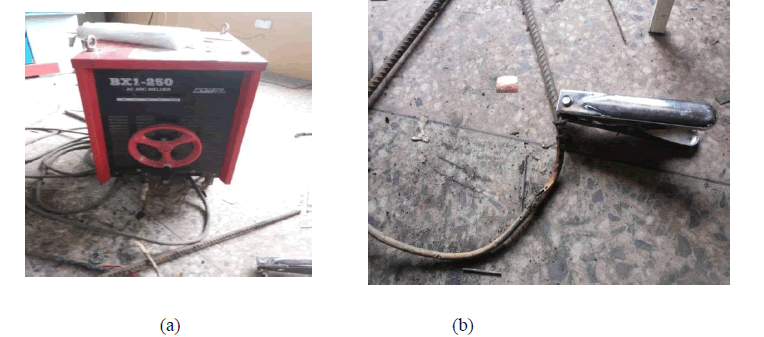 |
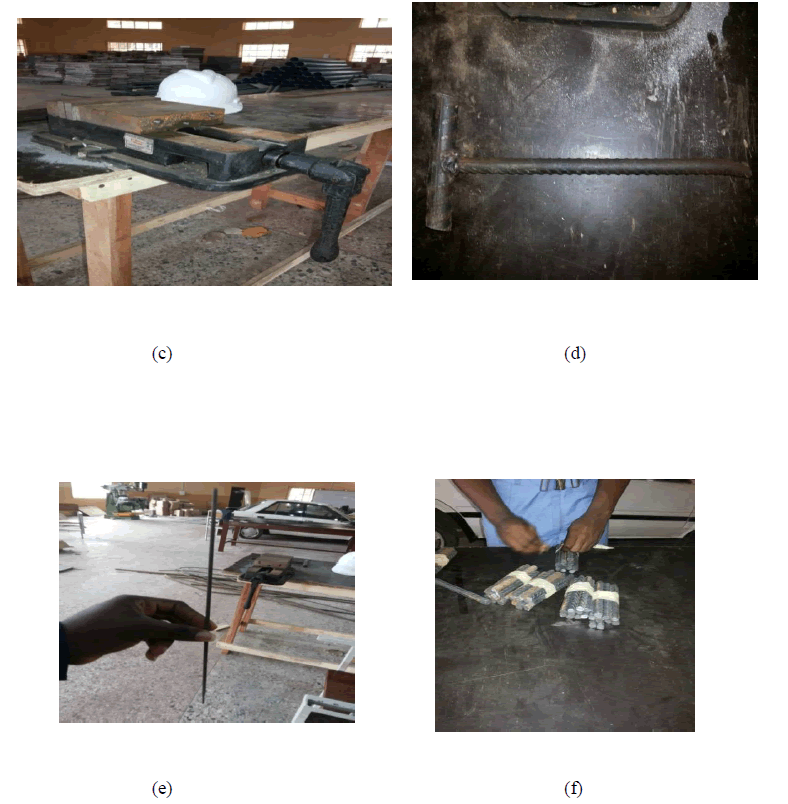 |
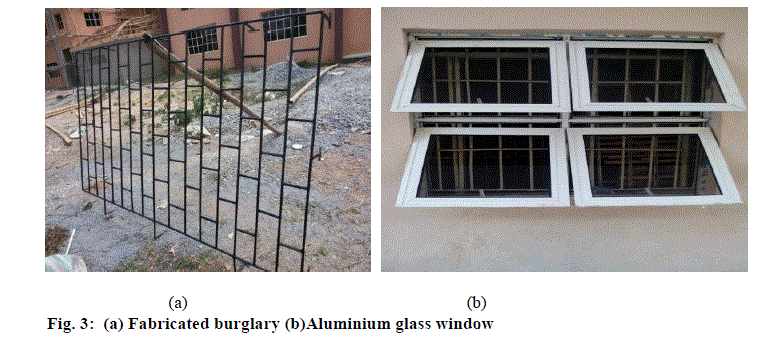 |
| Fig. 1: Materials, tools and equipment used in the fabrication of burglary (a) welding machine (b) return current cable (earth) (c) vice (d) locally made chipping hammer (e) electrode (f) cut 16 mm mild steel (g) hack saw (h) preliminary stage of burglary fabrication (i) advanced stage of burglary fabrication (j) designed burglary 1. Welding Machine: This machine is coupled with the electrode holder and the return current cable known as earth by non engineers. It is made up of primary coil and the secondary coil, with the two hands of the primary coil connected to the electric source bringing current into the welding machine and the two hands of the secondary coil connected to the electrode holder and the return current cable. From private study and literatures on welding, it was realized that the welding machine is working like a transformer because it convert electric current from the primary coil into electromagnetic field sent into the secondary coil used in welding the mild steel iron together [9]. 2. Vice: It is a holding tool used in holding the mild steel iron when cutting it. 3. Chipping Hammer: The Chipping hammer is used to remove some dark portion called slag or carbon that covers the welded portion and also using this hammer makes the welded portion to look like real metal. The chipping hammer was not available, locally improvised chipping hammer was made by welding two metals together to look like the chipping hammer. |
| 4. Hack saw: The arc saw blade was fixed to its frame and was used in cutting the mild steel iron. Arc saw is of different teeth/ blade i.e. the 18 or 24 teeth. Selection is based on type of work. 5. Electrode: In arc welding an electrode is used to conduct current through a work piece to fuse two pieces together. Electrodes are of different gauges but for the assembly process, gauge 12 was used and it’s of 2.5 mm thickness. If the electrode is positively charged, the base metal will be hotter, increasing weld penetration and welding speed. Alternatively, a negatively charged electrode results in more shallow welds [10]. |
V. DESIGN AND FABRICATION OF BURGLARY |
| The following is the description of the workdone while fabricating the burglary proof window: (1)Design of burglary: This involves detail calculation and drawing of the burglary to be fabricated. (2) Measuring of mild steel: This involves the measurement of the sixteen mm mild steel iron to prescribed lengths as shown in the detailed diagram. It is done with the aid of a measuring tape. (3)Cutting of Mild Steel: Mild steel were cut in accordance with the prescribed measurement and designed values using hand saw. |
| (4)Welding: Arc welding was used for the purpose of SWEP 2012/2013. It is welding process whereby coalescence is produced by heating the work piece with an electric arc set up between a flux coated electrode and the work piece. The shielded metal arc welding is the preferred type of arc welding because of his deep penetration. The flux covering decomposes due to arc heat. The electrode itself melts and supplies the necessary filler material. The students were told electric arc welding is used due to numbers of reasons, such as stable supply of electricity and also because the method is feasible. Also, arc welding may be done using direct current or alternating current (D.C or A.C) but for the purpose of this welding A. C. was used and during private study and research by consulting available textbooks and the internet, it was realized realize that using A.C current is preferable to D.C because it reduces the risk of environmental pollution in the sense that more carbon oxide will be emitted to the environment while using D.C. |
| Also, the current selection is based on the type of electrode gauge used and also the thickness of the mild steel iron to be welded. In the case of 12 gauge electrode, current selection would be within the range of 85amps – 100 amps and for 10 gauge electrode, current selection would be within the range of 100amps- 125amps. Current selection can easily be done by spinning the control gear on the welding machine. The first step in executing welding is Identification of welds, type of joint, calculation of weld area by stress analysis and preparation of drawing with specifications. This is followed by selection of appropriate welding process. Welding process execution therefore commences by putting electrode into the electrode holder and the earth is connected to the work piece. Then the two metals to be welded are connected and welded together but sometimes, base metals are needed and we were also told to ensure a distance of 1mm – 1.5mm between work and the electrode. The welding continued till all parts of the burglary were welded. This stage is followed by slag removal, weld dressing and testing by non destructive methods. |
| (5) Finishing: The burglary was then painted so as to beautify it and at the same time, to prevent corrosion. Also, the following materials, tools and equipment were used while assembling the aluminium widow frame |
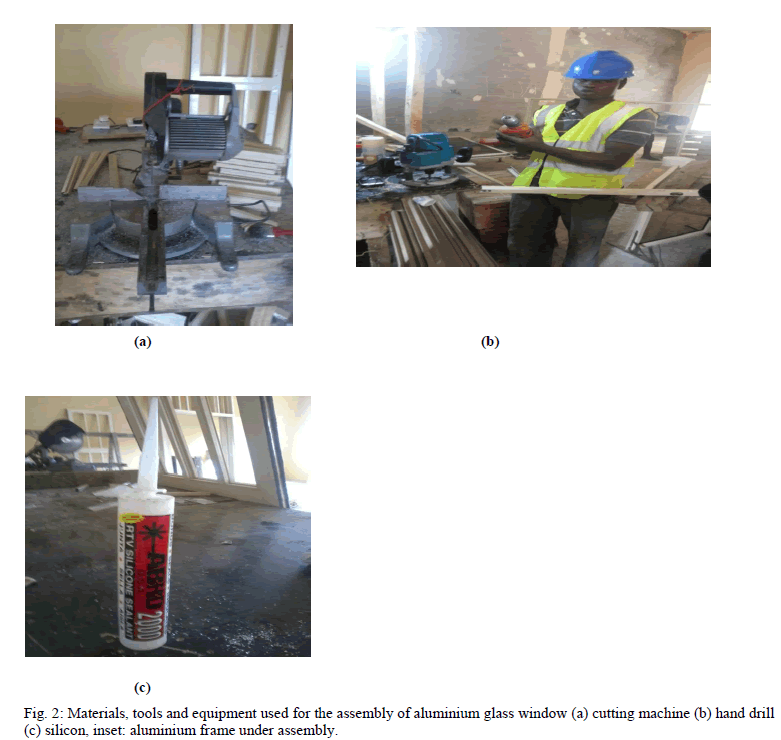 |
| 1. Cutting Machine: The cutting machine is used in cutting the aluminium frame into the required specification according to the given design. The machine consist of the track through which its slides through, the jack for adjusting itself into different positions and number of parts. 2. Hand Drill: During the process of assembling the aluminium frame, this machine is used to drill holes or secure the aluminium firmly with the glass. 3. Milling Machine: This machine is also used for machining flat surfaces and for producing holes to specification. 4. Hammer Mallet: It’s used to hit aluminium in other to amend, adjust or clinch it well together. 5. Files: It is used to smoothen parts of aluminium that is too sharp. 6. Screw driver: It is used to drive screws into holes joining two or more aluminium to form joints. 7. Pliers: The pliers is use to hold aluminium or other materials firmly during assembly. 8. Silicon: Use of silicon is part of finishing operation. It is used to cover clearances left up to 2 mm after the assembly has been fixed in its final position. 9. Window Roller: It is used in aiding sliding in sliding windows. Also, a closer is used in case of a swing door which enables the door to come back to close position after which it has been opened. 10. Diamond: It is used for cutting the glass. Diamond is specifically used because it is the hardest known substance and can easily penetrate any other substance. |
VI. ASSEMBLY OF ALUMINIUM GLASS WINDOW |
| The following shows the detail of the procedure undertaken while assembling aluminium glass window. (1) Design of aluminium frame to be assembled, which involve detail calculation and drawing. (2) Measuring aluminium to prescribed lengths as shown in the detail diagram with the use of measuring tape. (3) Cutting of aluminium in accordance with the prescribed measurement. (4) Drilling and milling of aluminium in accordance to design. (5) Cutting of the glass using diamond. Diamond is used because it is the hardest known substance and can go on glass easily. (6) Fixing glazing rubber round the glass. (7) Assembling of aluminium frame with the aid of screws. (8) Fitting of the glass into the already assembled aluminium frame. |
VII. EXPERIENCE GAINED |
| During the whole activities in the Mechanical workshop, welding which was assumed to be difficult by students was made easy through exposure to burglary fabrication exercise and also, techniques for assembling aluminium window frame was also made known. |
VIII. RESULTS AND DISCUSSION |
| After successful completion of the design and fabrication stages, 16 mm thick burglary was fabricated as shown in Fig. 3. Also, aluminium glass window was also assembled as shown in Fig. 3 |
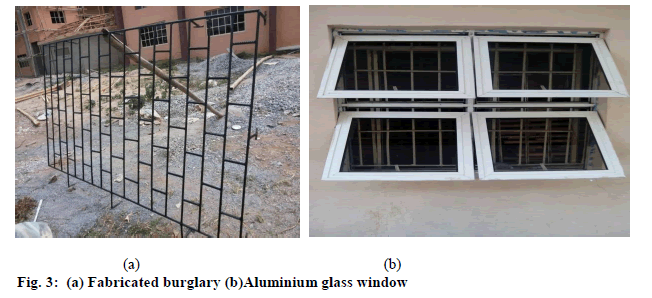 |
| The burglary was fabricated according to designed values and standard as shown in Fig. 3 Also, students can also assemble aluminium frame to standard with the aid of the knowledge gained during this exposure as shown in Fig. 3. The fabricated burglary was used within the university while the assembled aluminium glass window was fitted into the newly constructed engineering building also within the school as shown in Fig. 3, thus confirming conclusively that the work was skillfully and thoroughly done in line with modern and engineering practices. |
IX. CONCLUSION AND RECOMMENDATION |
| After the successful completion of the SWEP, the following conclusions were drawn: 1. The SWEP was feasible and economical. 2. The SWEP helps student to be conversant with mechanical laboratory/ workshop tools and machinery in preparation for longer period of industrial attachment. 3. Through the programme students’ innovative, creative abilities and skills were developed. 4. The programme was an avenue for students training on how to acknowledge and appreciate the numerous professional challenges of their immediate environment and the society at large thereby offering solutions, which their knowledge empowerment avails them. 5. It affords students great opportunity to match theory with practical works. Due to the challenges and constraints experienced during the course of executing this SWEP coupled with fact that there is room for further improvements on the programme, the following are hereby recommended: |
| (1) provision of more welding machine (2) Provision of adequate laboratory and workshop materials in mechanical engineering. (3) All materials produced should be used continually for more performance evaluation. (4) There should be increased awareness of the SWEP within the university community |
X. ACKNOWLEDGEMENT |
| The design and fabrication of burglary as well as aluminium window frame assembly was done at the mechanical engineering workshop of Afe Babalola University, Ado Ekiti, Nigeria. All the materials, tools and equipment used were supplied by the management of Afe Babalola University, Ado Ekiti, Nigeria. |
References |
|